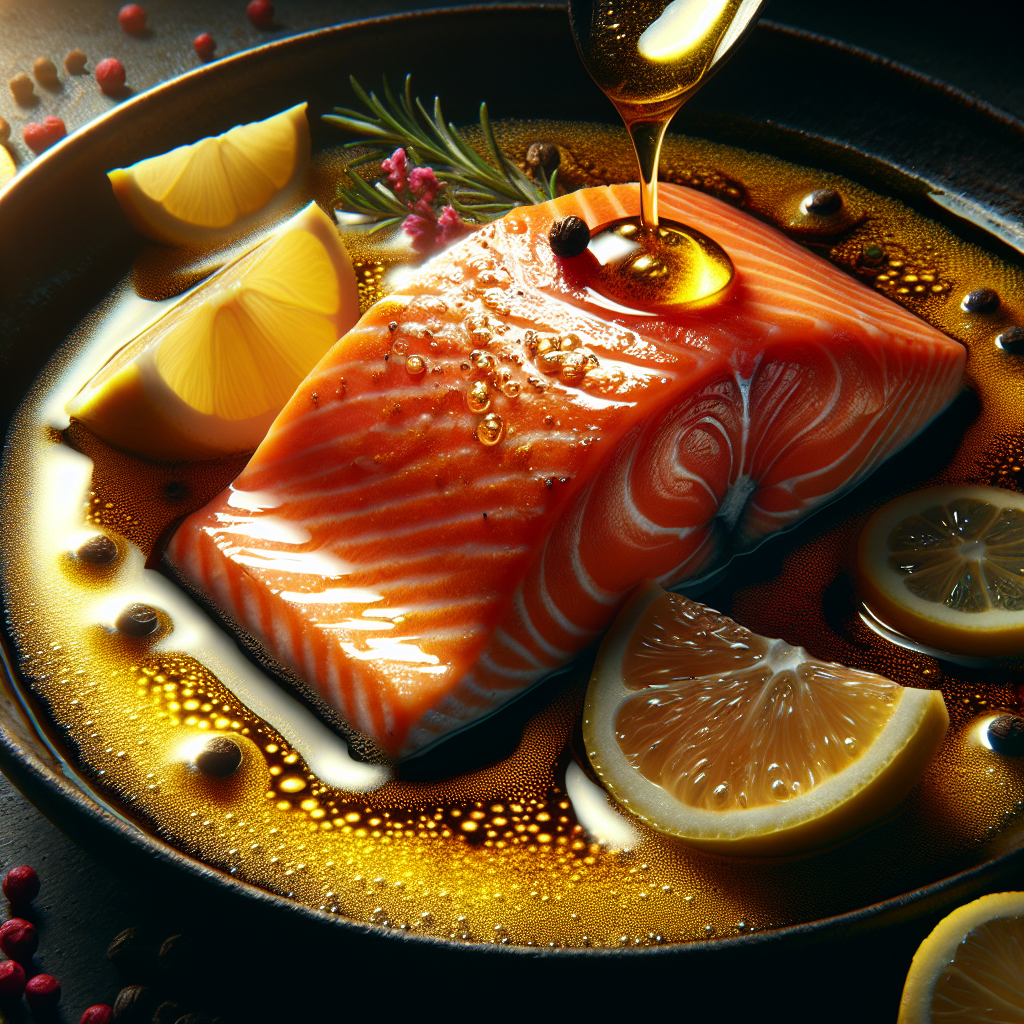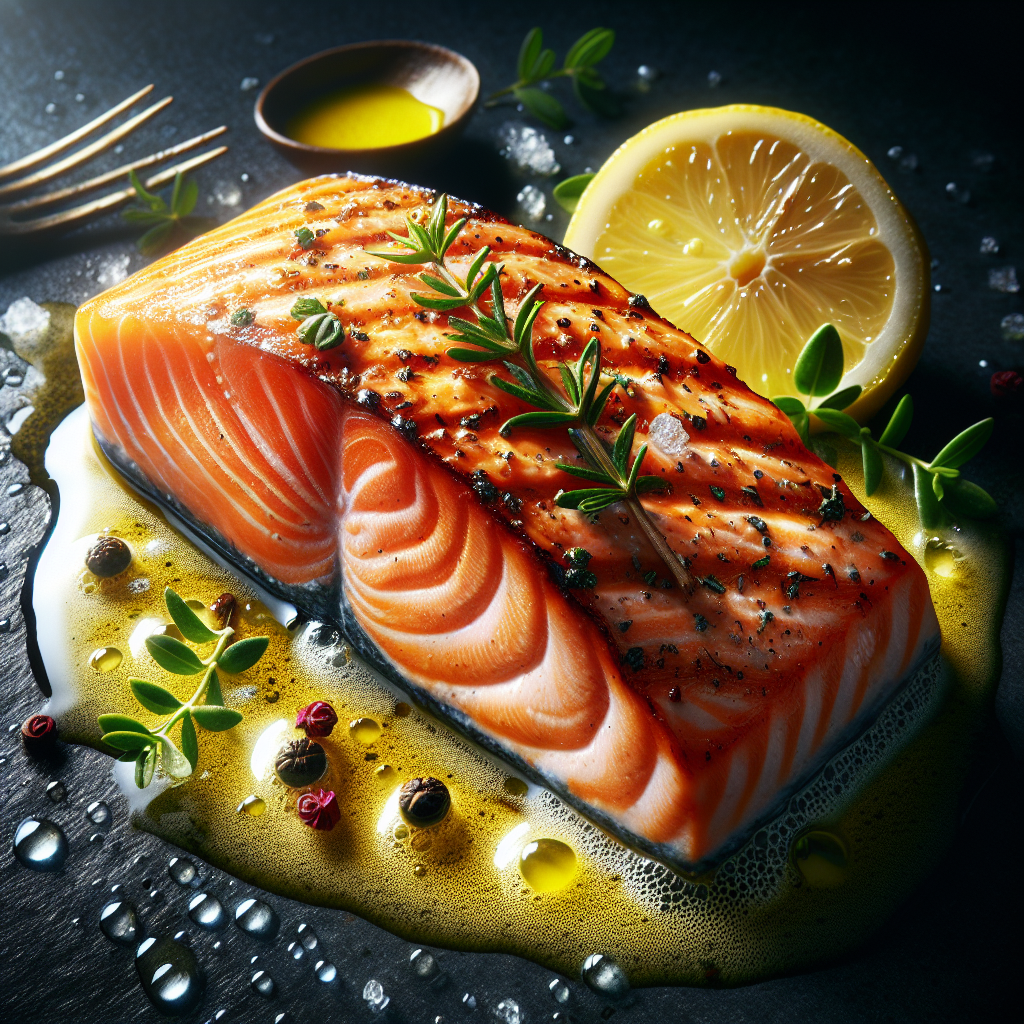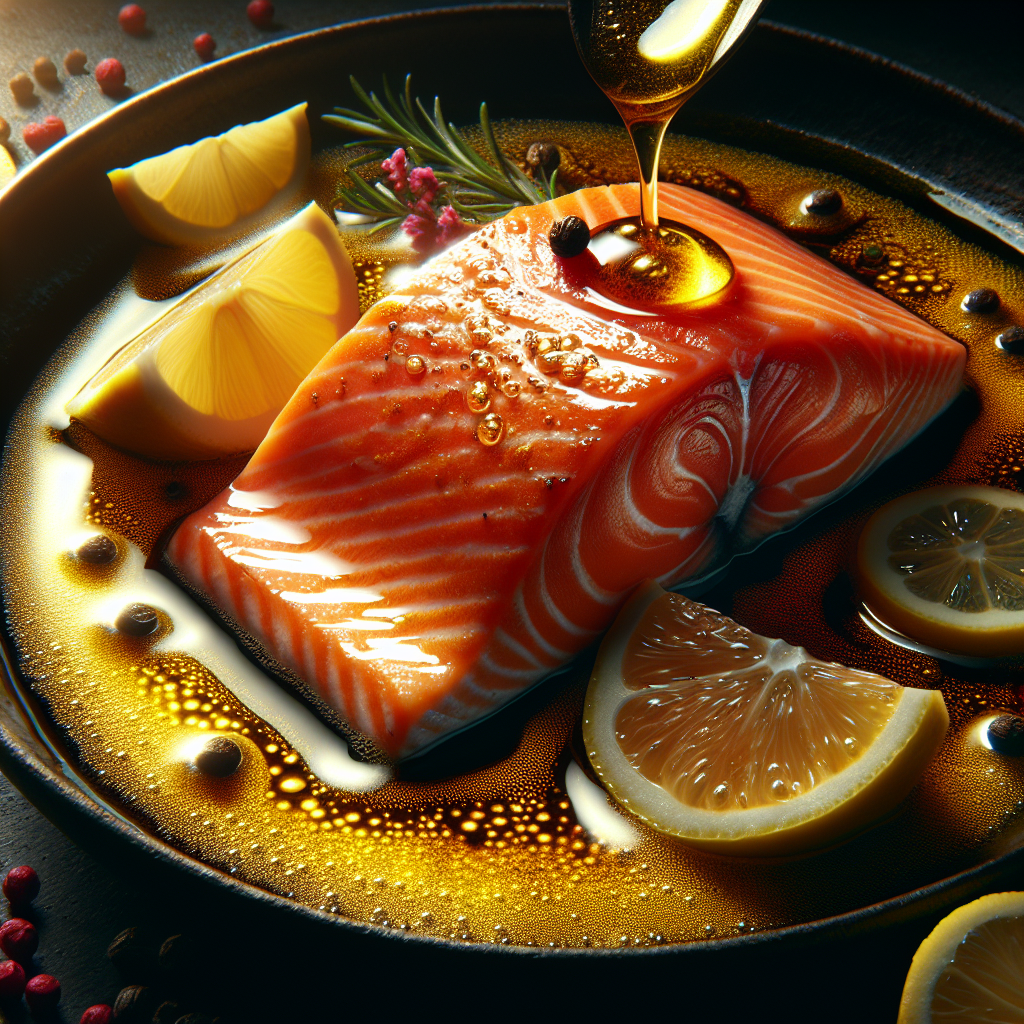You love the tender and flavorful taste of salmon, but each time you try to cook it at home, it turns out dry or overcooked. Don’t worry, because in this article, you will discover the ultimate guide on how to cook salmon. From choosing the freshest fish to exploring various cooking techniques, these valuable tips and tricks will help you achieve perfectly cooked and delicious salmon every time.
So get ready to elevate your salmon-making skills and impress your taste buds with restaurant-quality dishes in the comfort of your own kitchen.

Cook Salmon easy with this skillet (best seller)
Selecting the Right Salmon
When it comes to selecting the right salmon for your dish, there are a few factors to consider. One important decision is whether to choose fresh or frozen salmon. Fresh salmon is known for its vibrant color and delicate texture, while frozen salmon can be a convenient option that is available year-round.
Fresh salmon is typically caught and sold within a short period of time, so it maintains its natural flavor and texture. If you have access to a reliable fish market or local seafood store, purchasing fresh salmon can be a fantastic choice. On the other hand, frozen salmon is often flash-frozen shortly after being caught, which helps preserve its flavor and nutrients.
When it comes to the types of salmon, there are several options to choose from. The most common varieties include Atlantic salmon, Chinook salmon, Sockeye salmon, and Coho salmon. Each type has its own unique flavor profile and characteristics. Atlantic salmon is mild and rich, while Chinook salmon tends to be buttery and luxurious. Sockeye salmon is known for its deep red color and robust flavor, while Coho salmon offers a milder taste.
In addition to considering the freshness and type of salmon, sustainable choices are a crucial aspect to take into account. Overfishing can deplete fisheries and harm marine ecosystems. To make an environmentally friendly choice, look for salmon that is labeled as sustainable or certified by organizations such as the Marine Stewardship Council (MSC). These labels ensure that the salmon has been caught or farmed using practices that protect the environment and maintain healthy fish populations.
Preparing: How to cook Salmon
Once you have selected the perfect salmon for your meal, it’s essential to prepare it properly to enhance its flavors and ensure a delicious outcome. If you have chosen frozen salmon, it is crucial to thaw it correctly to prevent any loss of moisture or texture.
Cooking tips from Famous Chefs
Thawing frozen salmon can be done by placing it in the refrigerator overnight or by placing it in a sealed plastic bag and submerging it in cold water. Avoid thawing salmon at room temperature, as this can lead to bacterial growth. Once thawed, be sure to pat the salmon dry with paper towels to remove any excess moisture.
Before cooking, it is also necessary to remove any scales and pin bones that may still be present in the salmon fillet. Scaling can be done by using the back of a knife to scrape against the grain of the scales, starting from the tail and moving towards the head. Pin bones, which are small, thin bones that run along the center of the fillet, can be removed by using a pair of clean, sturdy tweezers or fish pliers. Gently grip the bone and pull it out in the same direction it is pointing until it releases from the flesh.
Cooking tips from Famous Chefs
Trimming and portioning the salmon fillet allows for more even cooking and a visually appealing presentation. To trim the fillet, use a sharp knife to remove any uneven or excess portions on the edges. To portion the fillet, divide it into individual servings based on your desired size.
Marinating and Seasoning
Marinating salmon is an excellent way to infuse it with additional flavors and enhance its natural taste. The process of marinating involves soaking the salmon in a flavorful liquid, allowing it to absorb the marinade’s aromas and flavors.
When marinating salmon, it is vital to keep in mind that seafood, including salmon, is delicate and can easily become overwhelmed by strong marinades. Opt for marinades that complement the salmon’s natural flavors, such as citrus-based marinades or blends of herbs and spices. Additionally, marinades containing ingredients like soy sauce, honey, or ginger can add depth and complexity to the dish.
If you prefer not to marinate your salmon, seasoning it directly with herbs and spices can also create a delightful flavor profile. Common herbs and spices that pair well with salmon include dill, lemon zest, garlic, paprika, and black pepper. Experiment with different combinations to find your perfect seasoning blend.
Grilling Salmon
Grilling salmon is a fantastic way to achieve a smoky and slightly charred exterior while keeping the flesh moist and tender. Before grilling, it is essential to prepare the salmon and the grill for optimal results.
To prepare the salmon for grilling, make sure it is at room temperature by removing it from the refrigerator about 15–20 minutes before cooking. This will ensure even cooking. Brush the fillets with a small amount of oil to prevent sticking to the grill grates, and season them with your desired herbs and spices.
When it comes to grilling techniques, there are a few options to consider. One method is grilling the salmon directly on the grates, ensuring the grates are clean, and preheating the grill to medium-high heat. Place the salmon skin-side down and cook for about 4-5 minutes per side, depending on the thickness of the fillets. Another technique is grilling the salmon on a cedar plank, which adds a smoky and earthy flavor to the fish.
To add some variety to your grilled salmon repertoire, try out some delectable grilled salmon recipes. One favorite is a sweet and tangy honey mustard glaze, which caramelizes beautifully on the grill. Another option is a zesty lemon herb marinade, infusing the fish with bright and refreshing flavors.

Baking Salmon
Baking salmon is a foolproof method that results in a tender and melt-in-your-mouth texture. To ensure a successful baked salmon dish, preheating the oven is crucial for even cooking.
Preheat the oven to the desired temperature, usually around 375°F (190°C). While the oven is heating up, prepare the salmon by seasoning it with salt, pepper, and your choice of herbs and spices. Line a baking sheet with parchment paper or aluminum foil for easy cleanup.
Place the seasoned salmon fillets on the prepared baking sheet and bake for approximately 12–15 minutes, depending on the thickness of the fillets. The salmon should be opaque and flaky when cooked through. For an extra burst of flavor, squeeze some fresh lemon juice over the salmon just before serving.
To explore different flavor profiles, try out some tasty baked salmon recipes. A classic option is maple-glazed salmon, with a delightful balance of sweet and savory flavors. Another delicious choice is a herb and garlic-crusted salmon, where the crispy crust adds texture and depth to the dish.
Pan-Searing Salmon
Pan-searing salmon allows for a crispy exterior while retaining a moist and flaky interior. To achieve the perfect pan-seared salmon, choosing the right pan is essential.
The ideal pan for pan-searing salmon is a heavy-bottomed skillet, such as a stainless steel or cast-iron pan. These pans distribute heat evenly, allowing for a well-seared crust.
Cook Salmon easy with this skillet (best seller)
To begin the pan-searing process, heat the skillet over medium-high heat and add a small amount of oil or butter. Once the oil is hot, carefully place the seasoned salmon fillets in the pan, skin-side down. Cook for approximately 4-5 minutes before flipping the fillets and cooking for an additional 2-3 minutes on the other side.
To add a burst of flavor and richness, try preparing some delicious pan-seared salmon recipes. A popular option is a garlic butter sauce, which imparts a decadent and flavorful touch to the fish. Another delightful choice is a soy and honey glaze, providing a perfect balance of salty and sweet flavors.
Poaching: Cooking Salmon
Poaching salmon results in a delicate and tender texture while also allowing it to absorb the flavors of a flavorful poaching liquid. To create a delicious and aromatic poaching liquid, a few key ingredients can elevate the dish.
Start by making a flavorful poaching liquid by combining ingredients such as vegetable or chicken broth, white wine, herbs like dill and thyme, lemon slices, and a pinch of salt and pepper. Bring the poaching liquid to a gentle simmer in a wide and shallow pan.
Once the poaching liquid is simmering, gently add the seasoned salmon fillets to the pan, ensuring they are fully submerged. Cover the pan and poach the salmon for about 10–12 minutes, or until the fish is opaque and flakes easily with a fork.
To explore an array of delightful poached salmon recipes, try a variation with a creamy lemon sauce that beautifully complements the tender fish. Another delicious option is a Thai-inspired poached salmon, infused with flavors of lemongrass, ginger, and coconut milk.
Broiling Salmon
Broiling salmon is an excellent choice for achieving a caramelized and slightly charred crust while keeping the fish moist and flavorful. To successfully broil salmon, it is crucial to prepare the broiler and the fish properly.
Before broiling, it is essential to preheat the broiler and adjust the rack to a position that allows the salmon to be about 4-6 inches away from the heat source. Brush the seasoned salmon fillets with a small amount of oil to prevent sticking, and place them on a broiler pan or a wire rack set on a baking sheet.
When broiling the salmon, keep a close eye on it as it can cook quickly under intense heat. Depending on the thickness of the fillets, broil the salmon for about 4-6 minutes on each side. The salmon should have a nicely browned crust while still being tender and moist on the inside.
To tantalize your taste buds with some mouthwatering broiled salmon recipes, try a tangy teriyaki glaze that adds delightful sweetness and savory notes to the fish. Another delectable choice is a herb and Parmesan crust, creating a crispy and flavorful topping.
Steaming Salmon
Steaming salmon is a gentle cooking method that preserves its natural flavors while ensuring a moist and delicate texture. To steam salmon to perfection, it is necessary to prepare the steamer and the fish properly.
To prep the steamer, bring water to a simmer in the bottom pan. Place the salmon fillets in a steaming basket or on top of a heatproof plate, ensuring they are not submerged in the water. Cover the steamer with a lid and steam the salmon for about 8–10 minutes, or until the fillets are opaque and flake easily.
To elevate the flavors of steamed salmon, create a steam infused with herbs, citrus, and other aromatic ingredients. For example, steam the salmon with fresh dill, lemon slices, and a sprinkle of salt and pepper for a classic and light flavor profile. Alternatively, experiment with a ginger and soy-infused steam for an Asian-inspired twist.
Serving Suggestions for Salmon
Once your perfectly cooked salmon is ready, it’s time to think about how to enhance the overall dining experience with delicious side dishes, garnishes, and sauces.
To complement the flavors of salmon, consider serving it with some mouthwatering side dishes. Grilled or roasted asparagus, garlic sautéed spinach, or a refreshing citrus salad can all be excellent choices that add a burst of color and flavor to the meal. Roasted baby potatoes or fluffy quinoa can also be delightful accompaniments, providing a satisfying and filling element.
When it comes to garnishes and sauces, they can elevate the presentation and taste of the salmon. A sprinkle of fresh herbs, such as dill or parsley, adds a touch of freshness and visual appeal. Lemon wedges or slices can bring a zesty and tangy element to the dish. As for sauces, classics like hollandaise or beurre blanc pair beautifully with salmon, while a tangy yogurt-dill sauce or a zesty mango salsa can provide a refreshing twist.
In conclusion, cooking salmon can be a delightful culinary adventure, whether you choose to grill, bake, pan-sear, poach, broil, or steam it. By selecting the right salmon, properly preparing it, marinating or seasoning it, and utilizing different cooking techniques, you can create a wide array of delicious and impressive salmon dishes. So go ahead and explore the possibilities; your taste buds will thank you!
Cook Salmon easy with this skillet (best seller)
Happy Cooking!


